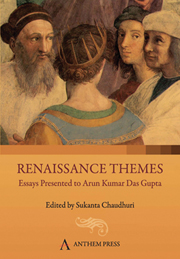Book contents
- Frontmatter
- Contents
- Preface
- List of Contributors
- Arun Kumar Das Gupta
- The Renaissance God as Man of Letters
- Ramist and Senecan Elements in Joseph Hall's The Art of Divine Meditation
- Hypocrite Lecteur: Reading on the Early Modern Stage
- Vertigo
- Folly and Androgyny: Shakespeare's King Lear
- ‘Fatal Visions’ in Macbeth
- The Miltonic Dissimile: Language and Style in Paradise Lost, Book 4
- ‘A Moving Grave’: Positioning Samson Agonistes
- Plate section
‘A Moving Grave’: Positioning Samson Agonistes
Published online by Cambridge University Press: 05 March 2012
- Frontmatter
- Contents
- Preface
- List of Contributors
- Arun Kumar Das Gupta
- The Renaissance God as Man of Letters
- Ramist and Senecan Elements in Joseph Hall's The Art of Divine Meditation
- Hypocrite Lecteur: Reading on the Early Modern Stage
- Vertigo
- Folly and Androgyny: Shakespeare's King Lear
- ‘Fatal Visions’ in Macbeth
- The Miltonic Dissimile: Language and Style in Paradise Lost, Book 4
- ‘A Moving Grave’: Positioning Samson Agonistes
- Plate section
Summary
Samson Agonistes is a difficult text to negotiate in the twenty-first century. The new face of terrorism and the war against terror, the currency of terms like jihad and suicide bombings in everyday vocabulary, the justifications suggested for many forms of the culture of violence in many corners of the world today cannot but have an impact on the way we now read Samson Agonistes. A ‘new alternative Samson’ had begun to emerge some time ago, reaching its culmination in John Carey's reading and in Joseph Wittreich's Interpreting Samson Agonistes, a Samson whose story is not an allegory of redemption but one of violence, lust and rash presumptions of divine guidance. More recently, in Shifting Contexts: Reinterpreting Samson Agonistes and Altering Eyes: New Perspectives on Samson Agonistes, as well as other recent works, Wittreich and other scholars have sought to open up a text long regarded as one to be examined for its conformity to scriptural traditions. The new readings begin with the beliefs
first, that Samson Agonistes is uncertain in its meanings, a deeply ambiguous text; second, that it is informed not by one but a multiplicity of traditions, each of them often in conflict, each of them just as often conflicted; and third, that if Milton's tragedy is inexplicable ‘in isolation from its scriptural source(s)’ and their ‘dialogic interplay’ in the poem […], those scriptural contexts are, as has not always been recognized, inextricably involved with the classical tradition of tragedy.
- Type
- Chapter
- Information
- Renaissance ThemesEssays Presented to Arun Kumar Das Gupta, pp. 127 - 144Publisher: Anthem PressPrint publication year: 2009



